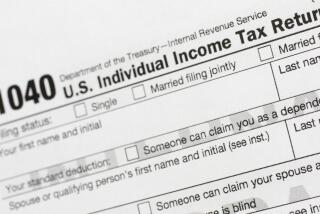Are Americans Overtaxed?
- Share via
WASHINGTON — Are taxes going up, up, up year after year without any respite? Have they wiped out the gains in income that Americans have won over the past several years? Are the rich escaping their fair share of taxes?
Many Americans believe the answers to all of these is “yes” and much more.
To be sure, the tax system is complex, and different sets of figures can point to different conclusions. But statistics gathered by the Internal Revenue Service and the nonpartisan Congressional Budget Office and Joint Committee on Taxation--and reviewed by private analysts--suggest that many popular notions about the tax system are myths.
Myth No. 1: Americans are overtaxed.
That’s a matter of judgment, of course, but one thing is certain: The tax burden in the United States is nowhere near as great as most Americans have been led to believe.
Politicians are fond of quoting the Tax Foundation, an anti-tax group, which contends that Americans on average will pay 35.4% of their income this year in federal, state and local taxes combined. The figure has been rising steadily for several years.
But Robert Greenstein, director of the liberal-oriented Center on Budget and Policy Priorities, complains that the Tax Foundation’s figures give too much weight to upper-income taxpayers, who face substantially greater tax burdens than most Americans. (See Myth No. 4.) Most mainstream analysts agree.
Figures compiled by the CBO and Congress’ Joint Committee on Taxation--both currently run by Republican appointees--show that median-income American families pay only 26% to 29%, depending on which taxes are included.
What has changed is the composition of the taxes that Americans pay. At the federal level, for example, today’s wage-earners pay far more of their total taxes in Social Security payroll taxes and user fees than once was the case, and proportionately less in federal income taxes. But they are getting more back in Social Security benefits, which have risen sharply. The table below divides taxpayers according to their income into five groups of equal size and shows two estimates of what share of their income they pay in federal taxes alone.
TWO ESTIMATES OF TAX BURDEN
Congressional Budget Office
Joint Committee on Taxation
(estimates of % of income paid in federal taxes)
Lowest
Second lowest
Middle
Second-highest
Highest
All Taxpayers
Myth No. 2: Americans’ tax burden keeps going up and up.
Tax experts say it simply isn’t so. Figures compiled by the Office of Management and Budget show that the overall federal tax burden--federal receipts as a percent of the gross domestic product--has remained remarkably flat [at just under 20% of the nation’s output] for the past 45 years.
Congress hiked federal taxes in 1990 and 1993, but that was primarily on the rich. Treasury Department figures show that for a typical family of four earning the median income, the average income tax rate was 6.6% in 1955 and is 7.8% in 1998, on its way down from a peak of 11.8% in 1981 (before the tax cuts in the Ronald Reagan administration).
And the marginal tax rate for the richest Americans--the top tax rate they pay on their income--has plunged from more than 90% in the 1950s and 1960s to 39.6% now.
Myth No. 3: Rising tax burdens have wiped out the gains in income and other compensation that Americans have won over the past several years.
It may seem that way, but the statistics show otherwise.
In the first place, after inflation is taken into account, not everyone’s income has risen during the past 20 years. The gains have been concentrated at the top of the income ladder; for the rest, there are relatively few gains for new taxes to have wiped out.
It’s true that very high-income Americans are paying more in taxes than they did a decade or two ago. But their incomes have risen far faster than their tax payments, with the result that their tax burden is actually at its lowest level in the 1990s.
The table shows the combined federal income and payroll tax rates paid by families of four at three income levels.
*--*
One-half Twice Median Tax Median Tax Median Tax income rate income rate income rate 1955 $2,460 2.0% $4,918 7.4% $9,838 11.6% 1965 $3,900 5.8% $7,800 8.3% $15,600 12.2% 1975 $7,924 10.0% $15,848 14.8% $31,896 17.5% 1985 $16,389 13.6% $32,777 17.4% $65,554 21.0% 1990 $20,726 12.8% $41,451 17.0% $82,902 19.8% 1991 $21,526 12.7% $43,052 16.9% $86,104 20.3% 1992 $22,128 12.0% $44,251 16.8% $88,502 20.1% 1993 $22,581 12.0% $45,161 16.8% $90,322 20.1% 1994 $23,506 11.0% $47,012 16.8% $94,024 20.2% 1995 $24,844 11.1% $49,687 16.8% $98,374 20.3% 1996 $25,759 10.6% $51,518 16.8% $103,036 20.1% 1997 $26,350 10.3% $52,700 16.8% $105,400 20.4% 1998 $26,860 7.1% $53,720 15.4% $107,440 19.7%
*--*
Source: U.S. Department of the Treasury
Myth No. 4: The rich are escaping their fair share of taxes.
That may have been a popular rallying-cry among tax-reform advocates in the 1960s, but these days it simply isn’t true, analysts assert. Thanks to tax increases on the rich pushed through in 1986, 1990 and 1993, upper-income Americans are paying a good deal more in taxes than they used to and sheltering far less of their earnings.
The CBO estimates that Americans in the top 5% of the income scale--those making $250,000 a year or more--pay 32.3% of their incomes in federal income, payroll, corporate and excise taxes--up from 26.7% a decade ago. By contrast, taxes paid by the middle fifth of the population amount to 19.7% of income.
The higher payments stem from several factors: The earnings of upper-income Americans are rising more rapidly than those of low- and middle-income families. Richer families are benefiting more from the booming stock market. And--contrary to some expectations--relatively few well-off taxpayers are trying to escape payment of taxes by sheltering their incomes.
Indeed, the unexpectedly high tax windfall coming from upper-income Americans has been a major factor in eliminating the overall federal budget deficit more quickly than government prognosticators previously had figured.
The table shows the share of income paid in federal taxes for seven income categories.
*--*
Individual Social Corporate Total Income Income Security Income Excise Federal Category Taxes Taxes Taxes Taxes Taxes Richest 1% 23.0% 3.0% 9.5% 0.2% 35.7% Richest 10% 18.0% 6.7% 5.8% 0.4% 30.8% Richest 20% 16.2% 8.0% 4.6% 0.5% 29.3% Second-richest 20% 9.0% 11.3% 1.4% 1.0% 22.7% Middle 20% 6.3% 10.8% 1.4% 1.2% 19.7% Second-poorest 20% 1.7% 9.9% 0.9% 1.6% 14.2% Poorest 20% -6.9% 7.8% 0.5% 2.8% 4.2%
*--*
Source: Congressional Budget Office
Myth No. 5: Tax rates in America are the highest in the world.
A 1994 study by Thomas Neubig and Perry D. Quick showed that taxes in the United States are lower as a percentage of its economy (as measured by the gross domestic product) than in any of the other seven major industrial nations. And while other countries’ tax burdens have increased substantially over the past 25 years, that of the U.S. has remained relatively constant.
Neubig says developments since 1991 have changed the specific figures, but not the thrust of his original study
New OECD figures also show that the marginal tax rate--or top rate on individual taxes--is lower for Americans than it is for taxpayers in any of America’s trading partners except Britain:
Total Government Tax Revenues as a Percentage of Gross Domestic Product
*--*
1965 1970 1975 1980 1985 1990 1991 France 34.5 35.1 36.9 41.7 44.5 43.8 44.2 Italy 25.5 26.1 26.2 30.2 34.5 39.1 39.7 Germany 31.6 32.9 36.0 38.2 38.1 36.8 39.2 Canada 25.9 31.3 32.4 31.6 33.1 37.0 37.3 Britain 30.4 36.9 35.5 35.3 37.8 36.7 36.0 Japan 18.3 19.7 20.7 25.4 27.6 31.4 30.9 United States 25.8 29.2 29.0 29.3 28.7 29.5 29.8
*--*
Source: Organization for Economic Cooperation and Development


